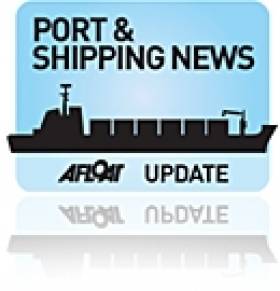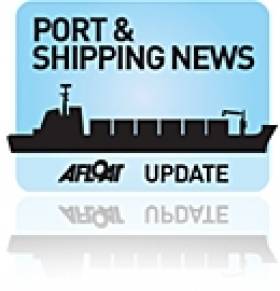Displaying items by tag: Guinness Ships
#Cementships - A cement cargoship due to dock in Dublin Port today from Runcorn on the Manchester Ship Canal is where until the early 1990’s Guinness imported to the UK using their own stout tankers, writes Jehan Ashmore.
That trade in transporting Guinness by custom-built ships, The Lady Patricia and Miranda Guinness were replaced by road-tankers, however the Irish connection with Runcorn remains with Ecocem. The Irish-owned company manufactures low-carbon cement products and just over a year ago they opened a new terminal in Runcorn to increase imports to a booming UK market.
An example of this Irish Sea trade is the Cemgulf (2001/3,925grt) a cement-carrier that is to berth at Dublin’s Deepwater Berth, from where Ecocem also export products across Europe. The appearance of this cement-carrier resembles somewhat that of the Guinness ship, The Lady Patricia (see photo). That been the cargo deck amidships structure that was added during conversion following removal of deck-mounted cranes.
The Cypriot flagged Cemgulf has pneumatic loading and self-discharging equipment, though the vessel launched as general cargoship Bornholm was converted in 2006. Fleetmates of Cemgulf that also call to Dublin are operated by German owner, Baltrader Capital GmbH & Co. KG of Hamburg.
On arrival of Cemgulf, the ship is to berth close to Ecocem’s production plant in Ringsend at a site on Pigeon House Road. The state of the art 8,000sqm facility manufacturers GGBS or ground granulated blastfurnace slag cement. Also located nearby at Poolbeg is the new Covanta Energy Ireland incinerator plant that yesterday took its first delivery of waste.
As regards to cement products they are supplied to a range of sectors and not just land-based but marine-engineering projects that are exposed to more severe environments. Marine projects that have used such specialist cements have included the development of the new Greystones Harbour. An example in the UK is the Redcar Sea Defence Units on the Kent coast.
#CanalCruises – Operators of the famous ferry cross the Mersey will again be launching Manchester Ship Canal Cruises starting in early April, writes Jehan Ashmore.
Treat yourself to the leisurely 6 hour return cruise along the 35 mile canal. To wet your appetite click HERE for a taster of the passage by viewing the Mersey Ferries TV Advert.
The canal cruise can start at Salford Quays (M50 3AH); or at the opposite end of the route from either our Seacombe (Wirral CH44 6QY) or Liverpool (L3 1DP) terminals.
Take in the spectacular scenery whilst a live commentary tells the story of how this magnificent waterway shaped the city of Manchester and the North West of England.
Over the passage of time, Runcorn (near the start of the canal) and Salford Docks where locations for the discharging of Guinness.
The 'black-stuff' was transported across the Irish Sea by the last of the stout-tankers The Lady Patricia and Miranda Guinness.
The trade ceased two decades ago in 1993 following the introduction of road-stout tankers that take the ferry instead.
Another Irish Sea route connection to Dublin Port had up untill recently operated two container vessels from Liverpool, however one of these ships, Coastal Deniz has shifted to a newly upgraded domestic service.
The service which is operated by this larger container vessel is running between Liverpool's Seaforth Container and the Irlam Container Terminal, near Trafford Park in Manchester.
Due to a marked increase in trade along the canal from customers among them Kelloggs, a trail-run period in running Coastal Deniz during January had proved successfull, leading to the transfer of the 260 TEU capacity vessel operated by Peel Ports.
The deployment of the 1991 built vessel to the canal route will move in the region 20,000 containers during 2013. The service between Liverpool to Irlam will operate four times weekly. For more WorldCargoNews.com has a report.
Once you've finished your day of cruising, Mersey Ferries we'll return to your point of departure by dedicated bus transfer.
Tickets are available from only £36 per person. Advance booking is necessary. To book or for more information call 0151 330 1444 or visit this LINK.
#FORMER DUNDALK DREDGER – Hebble Sand (1963/757grt), a grab-hopper dredger which has remained in Dublin Port for more than one year departed Dublin Port and is currently heading for Campbeltown, on the Mull of Kintyre Peninsula, writes Jehan Ashmore.
As previously reported on Afloat.ie, the veteran vessel was purchased last October by Northern Ireland based Abco Marine Ltd. The marine-plant and engineering equipment company is headquartered in Lisburn. Prior to then the former Dundalk Port Company owned dredger had remained laid-up since her repositioning voyage from the Louth port in July of 2011.
The change of port, followed the transfer of the Dundalk Port Company assets, liabilities and operations to Dublin Port Company by an order of statutory instruments, which saw the capital port divest in the business of dredging.
Since then for the majority of her time spent in the port, she had moored in Alexandra Basin West, except for a short spell spent as reported at the nearby dry-dock facility after Abco brought the ship.
Yesterday she made the short passage across the basin to the river-berth alongside Ocean Pier in readiness for her first repositioning voyage under her new owners, in a career that has so far spanned just short of half a century.
This timeframe is pretty good going for a vessel, particularly engaged in the rough and tumble work of a humble dredger which remains in excellent condition. So her career continues and remarkably still retaining her original name since her launching from Richard (Shipbuilders) of Lowestoft who built her for British Dredging.
In this photo-link of the vessel in recent years, she is seen alongside Sir John Rogerson's Quay, Dublin Port, where she carried site preparatory work prior to the installation of the Samuel Beckett swing-bridge, which was towed on a barge from the Netherlands.
Note to the left of the small ship can be seen the gable-end of the last dockland warehouse sheds that were built on both sides of the campshires that line the Liffey, in an area now named the 'Docklands' quarter of the port.
With cargoships long gone, including the famous Guinness stout-tankers, the sheds historically represent the last such buildings in what was the 'real' docklands close to the inner-city.
One of the two-adjoining sheds (built in the 1880's) was occupied by BJ Marine and now the river-fronted 'Nama' property, formerly owned by the DDDA, have recently been placed on the market for sale or to let.
#FORMER DUNDALK DREDGER – The former Dundalk Port Company owned dredger Hebble Sand (1963/757grt) departed the dry-dock in Dublin Port last week in readiness for her new owners Abco Marine Ltd, writes Jehan Ashmore.
Last October the vessel was sold by Dublin Port Company to Abco. The marine plant company based in Hillsborough Co. Down specialises in support services in the construction, engineering and dredging projects in Northern Ireland, Scotland and the Isle of Man.
The self-propelled grab-hopper dredger currently remains berthed at Alexandra Basin in Dublin Port, awaiting her delivery voyage. Despite nearing half a century, the veteran vessel remains in excellent condition considering the rough and tumble associated with dredging.
She last sailed into Dublin Port in July last year following the transfer of the Dundalk Port Company assets, liabilities and operations to Dublin Port Company by an order of statutory instruments.
Against this background, Dublin Port Company decided to divest in dredging business resulting in placing the Dundalk registered ship on the market for sale. The small ship at first glance resembles the last of the Guinness ships, The Lady Patricia and the world's first custom built liquid-bulk (pumped on board) stout tanker Miranda Guinness.
Unfortunately these vessels with such strong and unique histories were not saved from the breakers-torch whereas the humble Hebble Sand continues as a working ship. She is a testament to her builders Richard (Shipbuilders) of Lowestoft who built her for British Dredging and subsequent owners spanning a career at a shave off fifty years.
Heritage Week: Maritime Lecture Seminar Day
Below is listing of the lecture programme and times.
12.30 – 1.30 pm. Neutral Ireland's Role in the Sinking of the Bismark, May, 1941. By Dr. Michael Kennedy, Executive Editor, Documents on Irish Foreign Policy, Royal Irish Academy.
1.30 – 2.30 pm. Traditional Boats of Ireland. - Wooden workboats from all the Maritime Counties of Ireland. By Darina Tully, Lecturer and Maritime Archaeologist.
2.30 – 3.30 pm. Too Many Bags in the Lifeboat. A Lifeboat Tragedy at Bray 1876. By James Scannell, Lecturer and P.R.O of the Old Dublin Society.
3.30 – 4.00pm. Model Boats, A short talk to accompany the exhibition. By Garry Mooney secretary of the Irish Model Boat Club.
4.00 – 5.00 pm. Maritime Guinness, The Ships, Yachts and Barges of the Guinness Dynasty. By Dr. Edward Bourke, Diver, Maritime Historian and Author of "Guinness, the Family, the Business and the Black Stuff"
5.00 – 6.00 pm. Ireland's Armada Heritage. The Story of the Spanish Armada of 1588.The discoveries of the wrecks on the Irish Coast and the recovery of artifacts. By Cormac Lowth, Lecturer, Author and Diver.
For further information contact Barney Yourell Mob: 087 900 7466 No seminar charge – donations accepted
Information in general on the Maritime Institute of Ireland can be found on www.mariner.ie and for all the other events held during the National Heritage Week go to www.heritageweek.ie/
- Dublin Bay News
- Maritime Institute of Ireland
- Irish Model Boat Club
- Dun Laoghaire Club
- Dun Laoghaire Harbour
- M.I.I.
- Dun Laoghaire News
- RNLI Lifeboats
- National Heritage Week
- Heritage Week
- Maritime Lecture Seminar
- Sinking of the Bismark
- Traditional Wooden Irish Boats
- Guinness Ships
- Model Boats
- Ireland's Armada Heritage
- Spanish Armada
- Dun Laoghaire Maritime Museum



























































